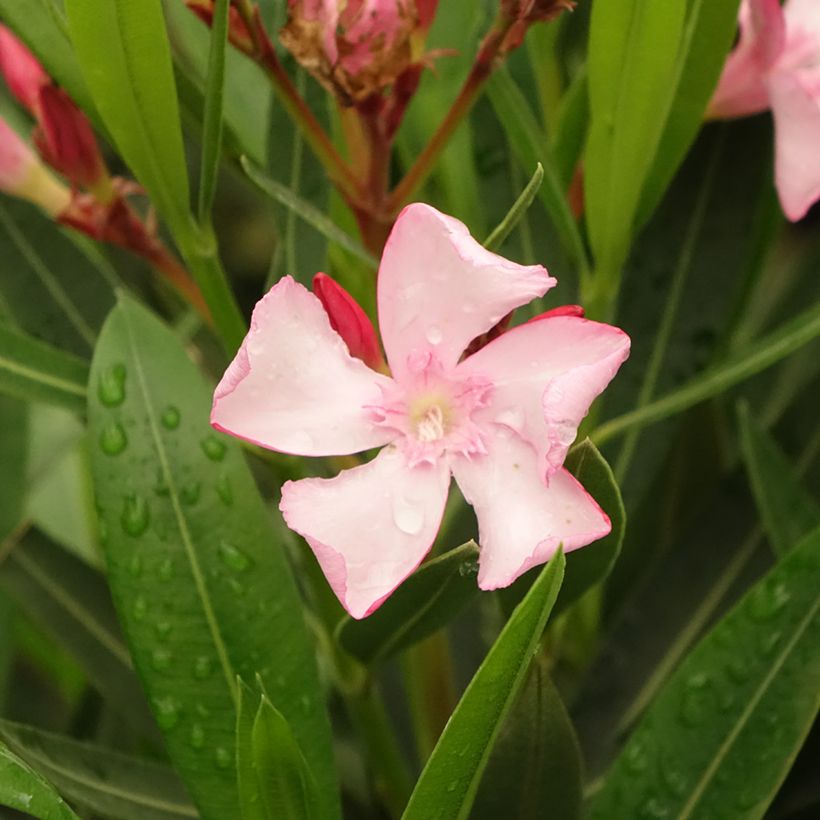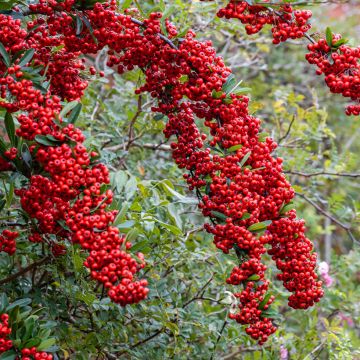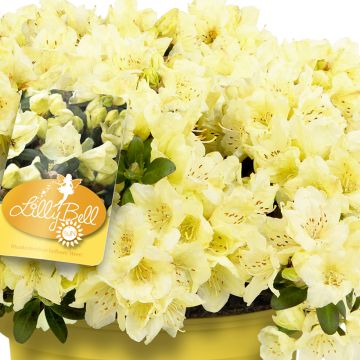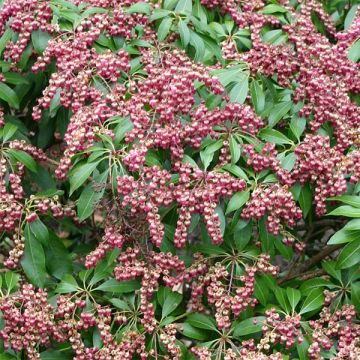

Nerium oleander Emilie


Nerium oleander Emilie
Nerium oleander Emilie
Nerium oleander Emilie
Oleander, Rose Bay
Very beautiful young plants, vigorous and already well-developed. Arrived in good condition.
Françoise, 29/04/2023
Special offer!
Receive a €20 voucher for any order over €90 (excluding delivery costs, credit notes, and plastic-free options)!
1- Add your favorite plants to your cart.
2- Once you have reached €90, confirm your order (you can even choose the delivery date!).
3- As soon as your order is shipped, you will receive an email containing your voucher code, valid for 3 months (90 days).
Your voucher is unique and can only be used once, for any order with a minimum value of €20, excluding delivery costs.
Can be combined with other current offers, non-divisible and non-refundable.
Home or relay delivery (depending on size and destination)
Schedule delivery date,
and select date in basket
This plant carries a 24 months recovery warranty
More information
We guarantee the quality of our plants for a full growing cycle, and will replace at our expense any plant that fails to recover under normal climatic and planting conditions.
Would this plant suit my garden?
Set up your Plantfit profile →
Description
The 'Emilie' Oleander is a descendant of Nerium oleander, a vigorous evergreen bush emblematic of Mediterranean gardens. This particularly floriferous variety blooms continuously from June to October if the soil remains moist, with single flowers of a soft and bright light pink. They are grouped in generous clusters, highlighted by elegant dark green foliage, attractive even outside the flowering period. Undemanding, easy to grow in any well-drained soil, resistant to sea spray as well as drought, its only weak point is its rather mediocre hardiness, especially during its early years. Cultivation in open ground should be reserved for regions that do not experience very cold winters. It can also be used in the composition of large, elegant and multicoloured hedges in combination with other varieties, and will impress in a large pot on the terrace or balcony, or in a small garden throughout the season.
The many cultivars of oleander available on the horticultural market are most often hybrids between Nerium oleander subsp. oleander, spontaneous around the Mediterranean, and Nerium oleander subsp. indicum, very fragrant, spontaneous from Iran to China. Their flowers are single, double, or even triple and offer an almost infinite palette of tones, from white to pink through yellow and salmon, red, and even mauve. Only the blue shade is absent.
The Nerium oleander is an evergreen bush of the Apocynaceae family, like periwinkles or the false jasmine (Trachelospermum jasminoides). 'Emilie' naturally forms a bush with a dense and bushy habit, ramified near the base, multi-stemmed, with an overall rounded habit. Vigorous, it will reach an average maturity of 3m50 (12 ft) in height and 3m (10 ft) in spread, with rapid growth. Its flexible branches, covered with grey bark, bear long evergreen leaves, thick and leathery, a bit bluish on their lighter underside. They measure 10 to 15cm (4 to 6 in) in length by 3cm (1.2 in) in width. In the case of intense drought Nerium loses some of its oldest leaves, those located at the base of the stems. Flowering takes place in spring and then again from the end of summer to autumn, or continuously over 4 to 5 months from spring to autumn in the right climate, in fresh soil. The flowers are composed of a tube flaring into 5 light pink petals, alongside thin and turbinate buds. They are gathered in corymbs, mainly at the terminal part of branches aged 1 or 2 years. This flowering, nectar-rich and honey producing, is followed by the formation of long reddish pods which burst when ripe, releasing a multitude of small seeds provided with a tuft of white bristles to be scattered by the wind. Be careful not to prune oleander too severely: only the stems that have reached a certain length bear flowers!
Symbol of resistance and generosity, Nerium oleander makes an excellent hedge plant by the sea, but also a magnificent standalone plant in a sunny site. Hardy down to -8/-10°C (17.6/14 °F) once well established, it will grow without problem in any ordinary but well-drained soil. It can be used as a hedge by pruning it regularly, combined with other evergreen bushes like Laurustinus, Elaeagnus ebbingei, Mexican Orange, myrtles, Pittosporum tobira or Grevillea. In a mild climate it can be trained as a small tree: select the best stem and bring that up to 1m50 or 2m (5 to 7 ft) from the ground before letting it branch out. The resulting subjects are particularly ornamental but require very mild winters that won't risk having to cut them back to the ground: you don't want to see several years of work destroyed by frost in a few hours! On the terrace it can live in a large pot, in the company of citrus trees, Grevillea and other oleanders. This allows the tree to be stored in a very bright, fresh but frost-free room over winter in very cold regions.
The genus name 'Nerium' may come from the ancient Greek name Nerion, derived from Nereus, a sea god of Greek mythology. Another interpretation sees Nerium coming from neros, which means "wet" in Greek. The liquid element common to both interpretations is probably explained by the fact that wild oleander never grows very far from water. Its long roots anchor deeply into the soil to draw moisture, even on the sides of gorges or the beds of dried-up rivers. As proof of its incredible resistance to drought, in arid regions like the Negev in Israel or the southern Anti-Atlas in Morocco, Nerium oleander is one of the only bushes (along with Acacia and Retama, a kind of broom) capable of surviving in the desert, anchored in the walls of ravines.
Report an error about the product description
Nerium oleander Emilie in pictures




Plant habit
Flowering
Foliage
Safety measures
Botanical data
Nerium
oleander
Emilie
Apocynaceae
Oleander, Rose Bay
Cultivar or hybrid
ingestion
Cette plante est toxique si elle est ingérée volontairement ou involontairement.
Ne la plantez pas là où de jeunes enfants peuvent évoluer, et lavez-vous les mains après l'avoir manipulée.
Pensez à conserver l'étiquette de la plante, à la photographier ou à noter son nom, afin de faciliter le travail des professionnels de santé.
Davantage d'informations sur https://plantes-risque.info
Planting and care
We advise planting oleander in the spring in cool regions, once the risk of frosts has passed, but preferably in early autumn in a hot and dry climate. Install it in a very sunny and sheltered site, or in partial shade in a hot climate, in deep soil that is well drained; it can tolerate some alkalinity or a rise in brackish water. Grown in the shade it will be much less floriferous and its habit will take on a more ungainly appearance, less bushy. While it accomodates drought and aridity very well, it will only reach its full potential and flower abundantly in soil that is sufficiently moist at depth. It resists sea spray very well. Monitor moisture levels during summer in the first two years. It will appreciate an addition of compost and a thick layer of dead leaves, especially over the first two winters in regions on the limit of its hardiness. Water should be applied around the foot of the plant and never on the foliage.
Pruning oleander requires some precautions: the bush only flowers on young branches that have reached a certain length (generally stems less than 1 year old, not too short). Therefore it is necessary not to cut back all the branches the same year, or you risk being deprived of flowers for the whole season. When necessary, pruning will be carried out in early spring. To form the Nerium on a trunk, you have to choose the best stem on the young plant, stake it, and cut all others back to ground level. During the first few years, all secondary branches that emerge from this 'trunk' at less than 1m (3 ft) to 1m50 (5 ft) from the ground will be systematically removed. The crown will then be treated according to the method outlined above.
Nerium is often the prey of scale insects, leading to the appearance of sooty mould on the foliage. Thin out and aerate the branches. You could treat with copper (Bordeaux mixture) in the spring. If a scale insect invasion is drastic, cut your oleander back to 10-20 cm (4-8 in) from the ground: its ability to regenerate from the stump is impressive, and the bush will regain its beautiful appearance in no time. Aphids can also settle on the flower buds: treat in the evening with a pyrethrin-based insecticide.
Oleander is also famous for the toxicity of its sap. It is worth noting that this has such a bitter and unpleasant taste that it is incredibly unlikely someone would ingest a sufficient quantity for it to be lethal. Most accidents come from confusion between oleander and bay laurel in cooking (though only bay laurel has that distinctive aroma), or from the use of branches as BBQ skewers.
Propagation is by cuttings from the current year's shoots, taken just after flowering or in early summer. A stem placed in water very easily produces fragile white roots: planting, into a pot filled with light potting soil, requires some precautions not to break them. Wean the cutting off water gradually, going from a substrate saturated with water to a potting soil simply kept moist. Transplant into open ground the following spring, or even at the end of the following summer in a mild climate.
Planting period
Intended location
Care
-
, onOrder confirmed
Reply from on Promesse de fleurs
Similar products
Haven't found what you were looking for?
Hardiness is the lowest winter temperature a plant can endure without suffering serious damage or even dying. However, hardiness is affected by location (a sheltered area, such as a patio), protection (winter cover) and soil type (hardiness is improved by well-drained soil).

Photo Sharing Terms & Conditions
In order to encourage gardeners to interact and share their experiences, Promesse de fleurs offers various media enabling content to be uploaded onto its Site - in particular via the ‘Photo sharing’ module.
The User agrees to refrain from:
- Posting any content that is illegal, prejudicial, insulting, racist, inciteful to hatred, revisionist, contrary to public decency, that infringes on privacy or on the privacy rights of third parties, in particular the publicity rights of persons and goods, intellectual property rights, or the right to privacy.
- Submitting content on behalf of a third party;
- Impersonate the identity of a third party and/or publish any personal information about a third party;
In general, the User undertakes to refrain from any unethical behaviour.
All Content (in particular text, comments, files, images, photos, videos, creative works, etc.), which may be subject to property or intellectual property rights, image or other private rights, shall remain the property of the User, subject to the limited rights granted by the terms of the licence granted by Promesse de fleurs as stated below. Users are at liberty to publish or not to publish such Content on the Site, notably via the ‘Photo Sharing’ facility, and accept that this Content shall be made public and freely accessible, notably on the Internet.
Users further acknowledge, undertake to have ,and guarantee that they hold all necessary rights and permissions to publish such material on the Site, in particular with regard to the legislation in force pertaining to any privacy, property, intellectual property, image, or contractual rights, or rights of any other nature. By publishing such Content on the Site, Users acknowledge accepting full liability as publishers of the Content within the meaning of the law, and grant Promesse de fleurs, free of charge, an inclusive, worldwide licence for the said Content for the entire duration of its publication, including all reproduction, representation, up/downloading, displaying, performing, transmission, and storage rights.
Users also grant permission for their name to be linked to the Content and accept that this link may not always be made available.
By engaging in posting material, Users consent to their Content becoming automatically accessible on the Internet, in particular on other sites and/or blogs and/or web pages of the Promesse de fleurs site, including in particular social pages and the Promesse de fleurs catalogue.
Users may secure the removal of entrusted content free of charge by issuing a simple request via our contact form.
The flowering period indicated on our website applies to countries and regions located in USDA zone 8 (France, the United Kingdom, Ireland, the Netherlands, etc.)
It will vary according to where you live:
- In zones 9 to 10 (Italy, Spain, Greece, etc.), flowering will occur about 2 to 4 weeks earlier.
- In zones 6 to 7 (Germany, Poland, Slovenia, and lower mountainous regions), flowering will be delayed by 2 to 3 weeks.
- In zone 5 (Central Europe, Scandinavia), blooming will be delayed by 3 to 5 weeks.
In temperate climates, pruning of spring-flowering shrubs (forsythia, spireas, etc.) should be done just after flowering.
Pruning of summer-flowering shrubs (Indian Lilac, Perovskia, etc.) can be done in winter or spring.
In cold regions as well as with frost-sensitive plants, avoid pruning too early when severe frosts may still occur.
The planting period indicated on our website applies to countries and regions located in USDA zone 8 (France, United Kingdom, Ireland, Netherlands).
It will vary according to where you live:
- In Mediterranean zones (Marseille, Madrid, Milan, etc.), autumn and winter are the best planting periods.
- In continental zones (Strasbourg, Munich, Vienna, etc.), delay planting by 2 to 3 weeks in spring and bring it forward by 2 to 4 weeks in autumn.
- In mountainous regions (the Alps, Pyrenees, Carpathians, etc.), it is best to plant in late spring (May-June) or late summer (August-September).
The harvesting period indicated on our website applies to countries and regions in USDA zone 8 (France, England, Ireland, the Netherlands).
In colder areas (Scandinavia, Poland, Austria...) fruit and vegetable harvests are likely to be delayed by 3-4 weeks.
In warmer areas (Italy, Spain, Greece, etc.), harvesting will probably take place earlier, depending on weather conditions.
The sowing periods indicated on our website apply to countries and regions within USDA Zone 8 (France, UK, Ireland, Netherlands).
In colder areas (Scandinavia, Poland, Austria...), delay any outdoor sowing by 3-4 weeks, or sow under glass.
In warmer climes (Italy, Spain, Greece, etc.), bring outdoor sowing forward by a few weeks.








































